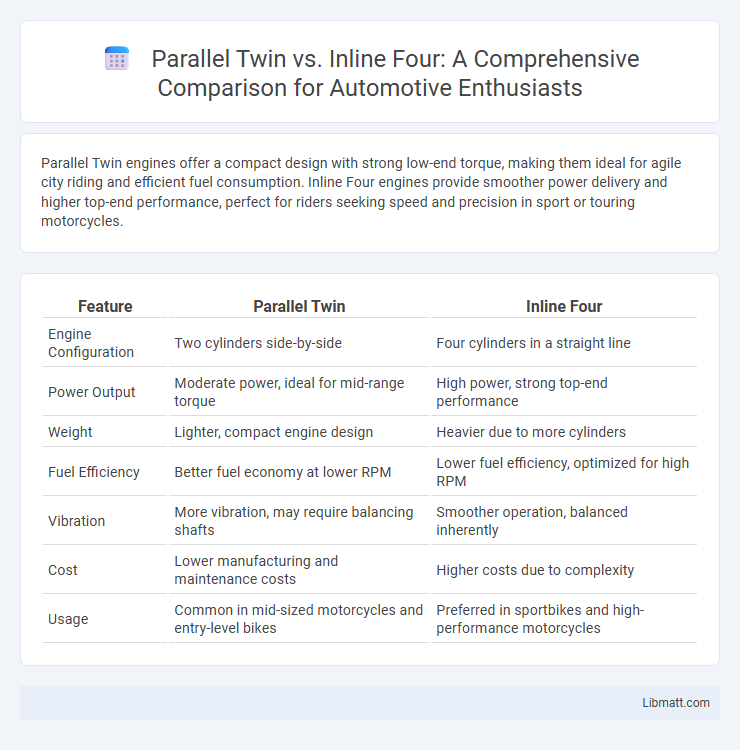Parallel Twin engines offer a compact design with strong low-end torque, making them ideal for agile city riding and efficient fuel consumption. Inline Four engines provide smoother power delivery and higher top-end performance, perfect for riders seeking speed and precision in sport or touring motorcycles.
Table of Comparison
| Feature | Parallel Twin | Inline Four |
|---|---|---|
| Engine Configuration | Two cylinders side-by-side | Four cylinders in a straight line |
| Power Output | Moderate power, ideal for mid-range torque | High power, strong top-end performance |
| Weight | Lighter, compact engine design | Heavier due to more cylinders |
| Fuel Efficiency | Better fuel economy at lower RPM | Lower fuel efficiency, optimized for high RPM |
| Vibration | More vibration, may require balancing shafts | Smoother operation, balanced inherently |
| Cost | Lower manufacturing and maintenance costs | Higher costs due to complexity |
| Usage | Common in mid-sized motorcycles and entry-level bikes | Preferred in sportbikes and high-performance motorcycles |
Introduction to Motorcycle Engine Configurations
Parallel twin engines feature two cylinders positioned side by side, offering a compact design with balanced power delivery and smooth acceleration, commonly favored for lightweight and mid-sized motorcycles. Inline four engines consist of four cylinders aligned in a single row, delivering higher horsepower and refined performance ideal for sport bikes and larger touring motorcycles. Choosing between a parallel twin and inline four depends on your preference for ride smoothness, engine complexity, and desired power output.
Understanding Parallel Twin Engines
Parallel twin engines offer a compact design with two cylinders arranged side by side, delivering a balance of power and efficiency ideal for various motorcycle types. This configuration provides smoother torque delivery and a lighter engine compared to inline four engines, which have four cylinders in a straight line and typically produce higher peak power but with more weight and complexity. Understanding these differences helps you choose an engine that matches your riding style and performance needs.
Exploring Inline Four Engines
Inline Four engines deliver smooth power through a balanced design with four cylinders aligned in a straight row, enhancing fuel efficiency and reducing vibrations. This configuration offers high-revving capability and consistent torque, making it ideal for various motorcycle and car models seeking performance and reliability. Understanding your engine's structure helps optimize maintenance and maximize riding or driving experience.
Key Differences Between Parallel Twin and Inline Four
Parallel twin engines feature two cylinders arranged side-by-side, providing a compact design and lighter weight compared to inline four engines, which consist of four cylinders aligned in a single row. Inline fours deliver smoother power delivery and higher RPM potential, resulting in better performance and acceleration, while parallel twins emphasize torque and fuel efficiency. The choice between parallel twins and inline fours impacts motorcycle balance, engine vibration, and maintenance complexity, with inline fours typically requiring more intricate engineering and higher production costs.
Performance Comparison: Power and Torque
The Inline Four engine typically delivers higher peak power and smoother high-rev performance, making it ideal for sport-oriented riding. Parallel Twin engines often produce stronger low to mid-range torque, enhancing acceleration and maneuverability in everyday riding conditions. Depending on your riding style, choosing between the instant torque of a Parallel Twin or the sustained power of an Inline Four can significantly influence your bike's performance experience.
Riding Experience: Vibration and Smoothness
Parallel Twin engines typically produce more noticeable vibration due to their firing interval and engine balance, which can affect rider comfort on long journeys. Inline Four engines are renowned for their exceptional smoothness, delivering a refined and vibration-free riding experience that enhances overall control and reduces fatigue. Riders seeking a smooth and steady ride often prefer the Inline Four configuration for its balanced power delivery and minimal engine shake.
Fuel Efficiency and Maintenance
Parallel twin engines typically offer better fuel efficiency compared to inline four engines due to their smaller displacement and reduced internal friction. Maintenance on parallel twins is generally simpler and less costly because of fewer moving parts and a more compact design. Inline four engines, while delivering higher performance, often require more frequent servicing and can incur higher repair costs.
Sound and Character: Engine Notes
Parallel twin engines produce a distinct, throaty exhaust note characterized by a deep, pulsing rumble due to their firing intervals and crankshaft design. Inline four engines deliver a smoother, higher-pitched sound with rapid-fire exhaust pulses, resulting in a more refined and aggressive character. The unique acoustic signatures influence rider preference, with parallel twins often favored for their muscular warmth and inline fours praised for their crispness and rev-happy nature.
Suitability for Different Riding Styles
Parallel twin engines deliver strong low-end torque and smooth power, making them ideal for urban commuting and relaxed cruising. Inline four engines excel at high-rev performance with rapid acceleration, suiting aggressive riding and sportbike enthusiasts who demand precise throttle response. Your choice depends on whether you prefer manageable power for everyday use or high-speed thrills on twisty roads.
Choosing the Right Engine for You
Choosing the right engine for your motorcycle depends on your riding style and performance preferences. A Parallel Twin engine offers a compact design with strong low-end torque, ideal for city commuting and agile handling. Inline Four engines provide higher peak power and smoother high-rev performance, making them suitable for speed enthusiasts who prioritize top-end acceleration and track capabilities.
Parallel Twin vs Inline Four Infographic

 libmatt.com
libmatt.com